Financial Markets and Institutes Report - Active vs Passive Funds
VerifiedAdded on 2020/05/03
|8
|1907
|33
Report
AI Summary
This report provides a comprehensive comparison of active and passive fund managers within the financial market. It begins with an executive summary and then delves into the characteristics of each type of fund manager, specifically mutual funds (active) and exchange-traded funds (passive). The report contrasts their strategic approaches, reviews their historical performance, and analyzes the market conditions impacting their operations. It examines the efficient market hypothesis in relation to fund performance and offers recommendations for future investors, considering factors like fees, financial goals, and risk tolerance. The report concludes by summarizing the advantages and disadvantages of both active and passive fund management, providing a clear overview for potential investors. The report references several sources to support its claims and analysis.
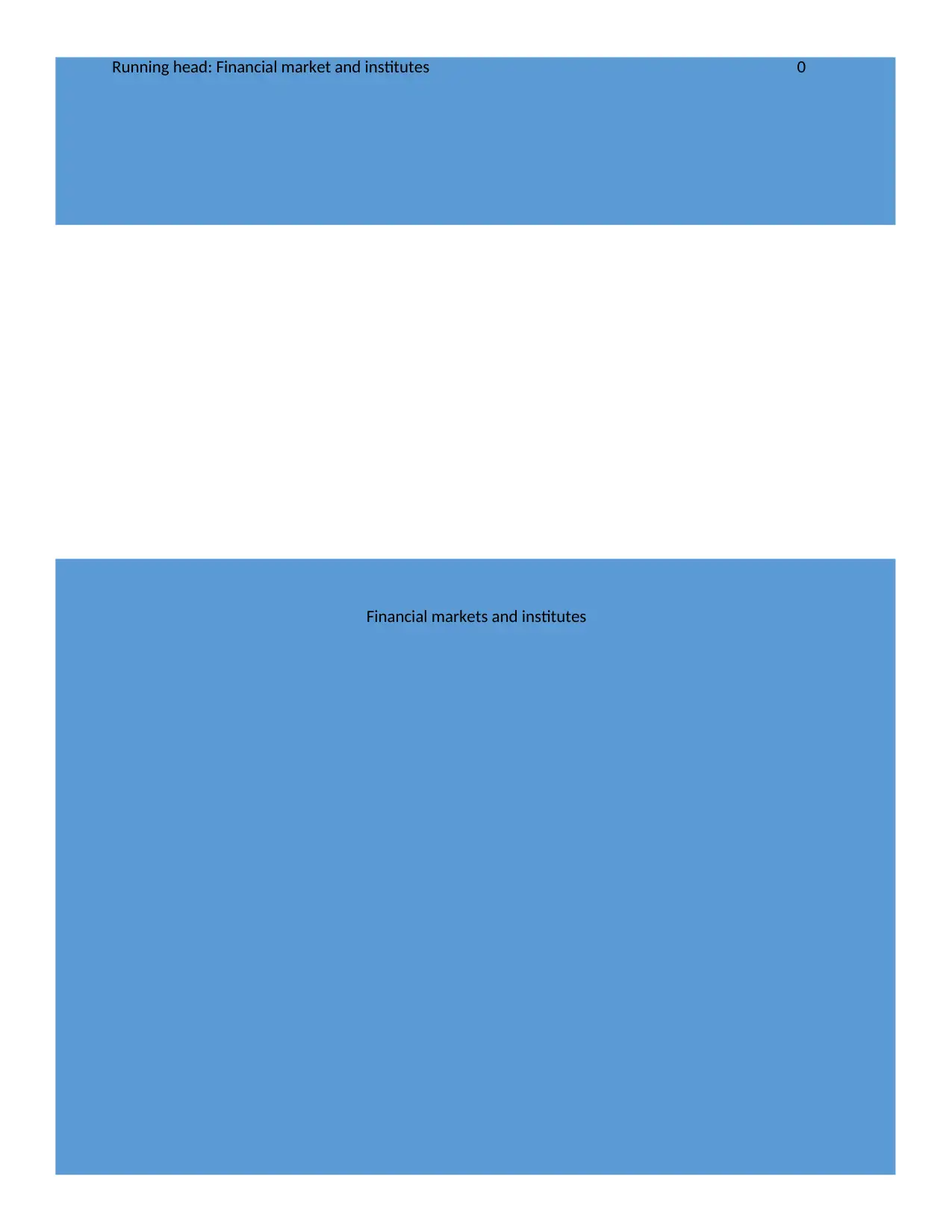
Running head: Financial market and institutes 0
Financial markets and institutes
Financial markets and institutes
Paraphrase This Document
Need a fresh take? Get an instant paraphrase of this document with our AI Paraphraser
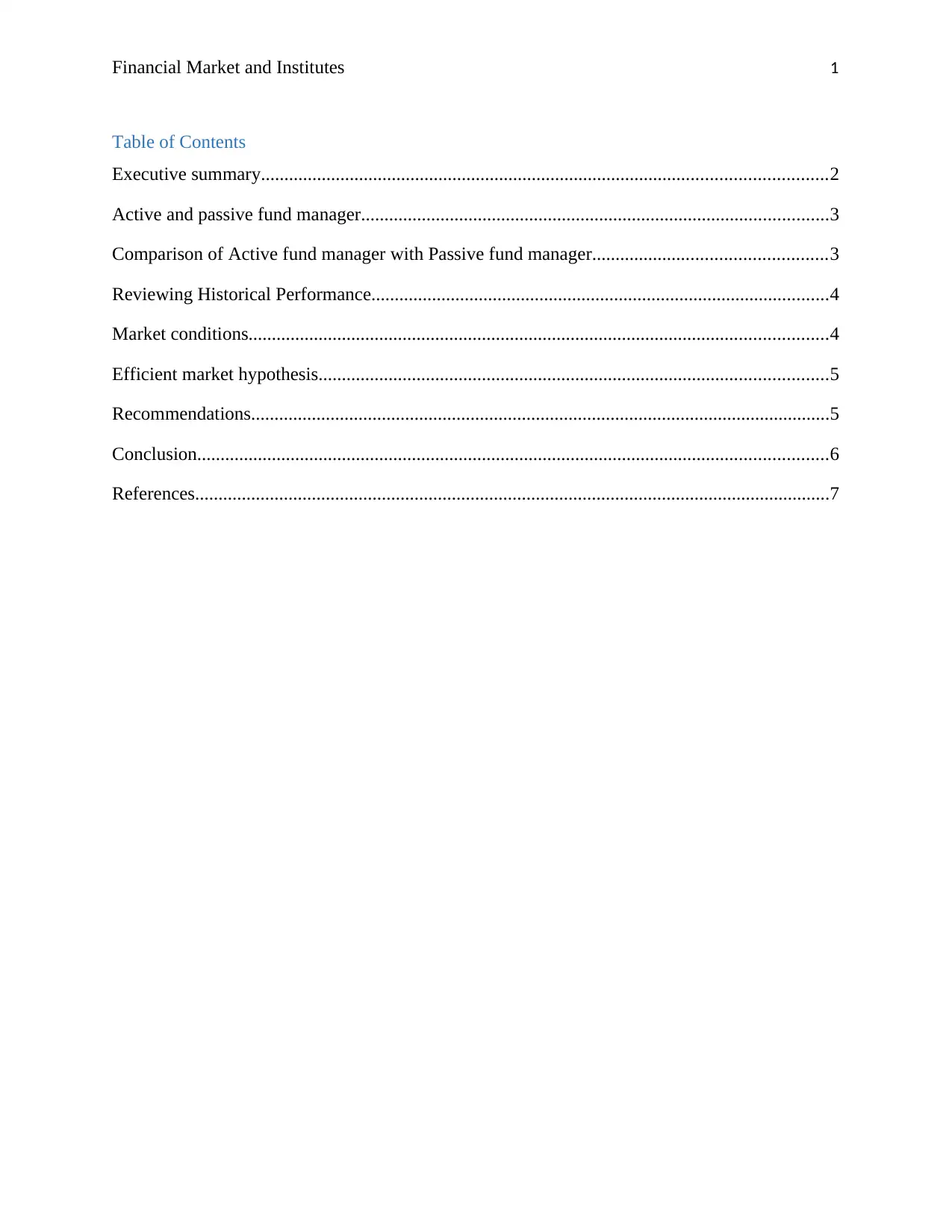
Financial Market and Institutes 1
Table of Contents
Executive summary.........................................................................................................................2
Active and passive fund manager....................................................................................................3
Comparison of Active fund manager with Passive fund manager..................................................3
Reviewing Historical Performance..................................................................................................4
Market conditions............................................................................................................................4
Efficient market hypothesis.............................................................................................................5
Recommendations............................................................................................................................5
Conclusion.......................................................................................................................................6
References........................................................................................................................................7
Table of Contents
Executive summary.........................................................................................................................2
Active and passive fund manager....................................................................................................3
Comparison of Active fund manager with Passive fund manager..................................................3
Reviewing Historical Performance..................................................................................................4
Market conditions............................................................................................................................4
Efficient market hypothesis.............................................................................................................5
Recommendations............................................................................................................................5
Conclusion.......................................................................................................................................6
References........................................................................................................................................7
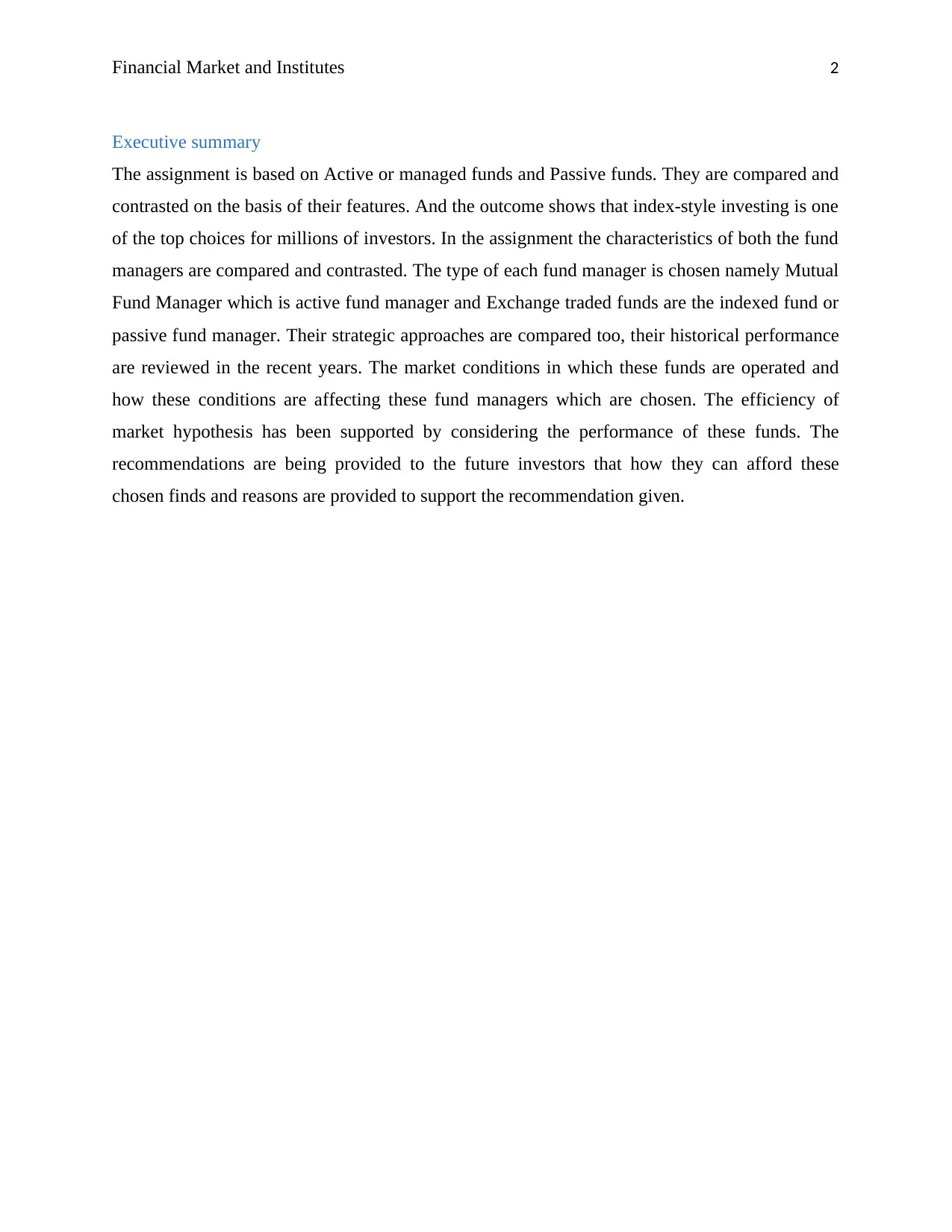
Financial Market and Institutes 2
Executive summary
The assignment is based on Active or managed funds and Passive funds. They are compared and
contrasted on the basis of their features. And the outcome shows that index-style investing is one
of the top choices for millions of investors. In the assignment the characteristics of both the fund
managers are compared and contrasted. The type of each fund manager is chosen namely Mutual
Fund Manager which is active fund manager and Exchange traded funds are the indexed fund or
passive fund manager. Their strategic approaches are compared too, their historical performance
are reviewed in the recent years. The market conditions in which these funds are operated and
how these conditions are affecting these fund managers which are chosen. The efficiency of
market hypothesis has been supported by considering the performance of these funds. The
recommendations are being provided to the future investors that how they can afford these
chosen finds and reasons are provided to support the recommendation given.
Executive summary
The assignment is based on Active or managed funds and Passive funds. They are compared and
contrasted on the basis of their features. And the outcome shows that index-style investing is one
of the top choices for millions of investors. In the assignment the characteristics of both the fund
managers are compared and contrasted. The type of each fund manager is chosen namely Mutual
Fund Manager which is active fund manager and Exchange traded funds are the indexed fund or
passive fund manager. Their strategic approaches are compared too, their historical performance
are reviewed in the recent years. The market conditions in which these funds are operated and
how these conditions are affecting these fund managers which are chosen. The efficiency of
market hypothesis has been supported by considering the performance of these funds. The
recommendations are being provided to the future investors that how they can afford these
chosen finds and reasons are provided to support the recommendation given.
⊘ This is a preview!⊘
Do you want full access?
Subscribe today to unlock all pages.

Trusted by 1+ million students worldwide
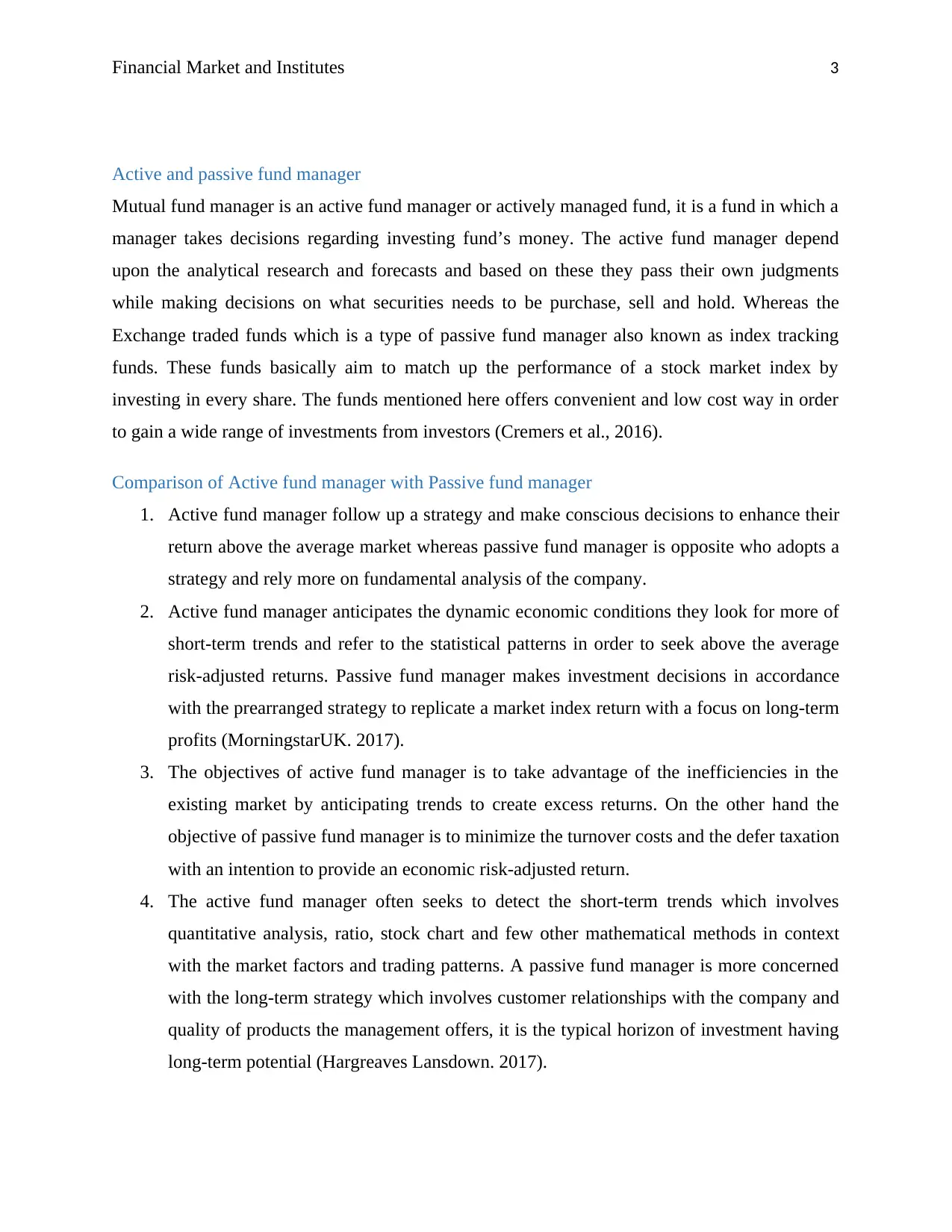
Financial Market and Institutes 3
Active and passive fund manager
Mutual fund manager is an active fund manager or actively managed fund, it is a fund in which a
manager takes decisions regarding investing fund’s money. The active fund manager depend
upon the analytical research and forecasts and based on these they pass their own judgments
while making decisions on what securities needs to be purchase, sell and hold. Whereas the
Exchange traded funds which is a type of passive fund manager also known as index tracking
funds. These funds basically aim to match up the performance of a stock market index by
investing in every share. The funds mentioned here offers convenient and low cost way in order
to gain a wide range of investments from investors (Cremers et al., 2016).
Comparison of Active fund manager with Passive fund manager
1. Active fund manager follow up a strategy and make conscious decisions to enhance their
return above the average market whereas passive fund manager is opposite who adopts a
strategy and rely more on fundamental analysis of the company.
2. Active fund manager anticipates the dynamic economic conditions they look for more of
short-term trends and refer to the statistical patterns in order to seek above the average
risk-adjusted returns. Passive fund manager makes investment decisions in accordance
with the prearranged strategy to replicate a market index return with a focus on long-term
profits (MorningstarUK. 2017).
3. The objectives of active fund manager is to take advantage of the inefficiencies in the
existing market by anticipating trends to create excess returns. On the other hand the
objective of passive fund manager is to minimize the turnover costs and the defer taxation
with an intention to provide an economic risk-adjusted return.
4. The active fund manager often seeks to detect the short-term trends which involves
quantitative analysis, ratio, stock chart and few other mathematical methods in context
with the market factors and trading patterns. A passive fund manager is more concerned
with the long-term strategy which involves customer relationships with the company and
quality of products the management offers, it is the typical horizon of investment having
long-term potential (Hargreaves Lansdown. 2017).
Active and passive fund manager
Mutual fund manager is an active fund manager or actively managed fund, it is a fund in which a
manager takes decisions regarding investing fund’s money. The active fund manager depend
upon the analytical research and forecasts and based on these they pass their own judgments
while making decisions on what securities needs to be purchase, sell and hold. Whereas the
Exchange traded funds which is a type of passive fund manager also known as index tracking
funds. These funds basically aim to match up the performance of a stock market index by
investing in every share. The funds mentioned here offers convenient and low cost way in order
to gain a wide range of investments from investors (Cremers et al., 2016).
Comparison of Active fund manager with Passive fund manager
1. Active fund manager follow up a strategy and make conscious decisions to enhance their
return above the average market whereas passive fund manager is opposite who adopts a
strategy and rely more on fundamental analysis of the company.
2. Active fund manager anticipates the dynamic economic conditions they look for more of
short-term trends and refer to the statistical patterns in order to seek above the average
risk-adjusted returns. Passive fund manager makes investment decisions in accordance
with the prearranged strategy to replicate a market index return with a focus on long-term
profits (MorningstarUK. 2017).
3. The objectives of active fund manager is to take advantage of the inefficiencies in the
existing market by anticipating trends to create excess returns. On the other hand the
objective of passive fund manager is to minimize the turnover costs and the defer taxation
with an intention to provide an economic risk-adjusted return.
4. The active fund manager often seeks to detect the short-term trends which involves
quantitative analysis, ratio, stock chart and few other mathematical methods in context
with the market factors and trading patterns. A passive fund manager is more concerned
with the long-term strategy which involves customer relationships with the company and
quality of products the management offers, it is the typical horizon of investment having
long-term potential (Hargreaves Lansdown. 2017).
Paraphrase This Document
Need a fresh take? Get an instant paraphrase of this document with our AI Paraphraser
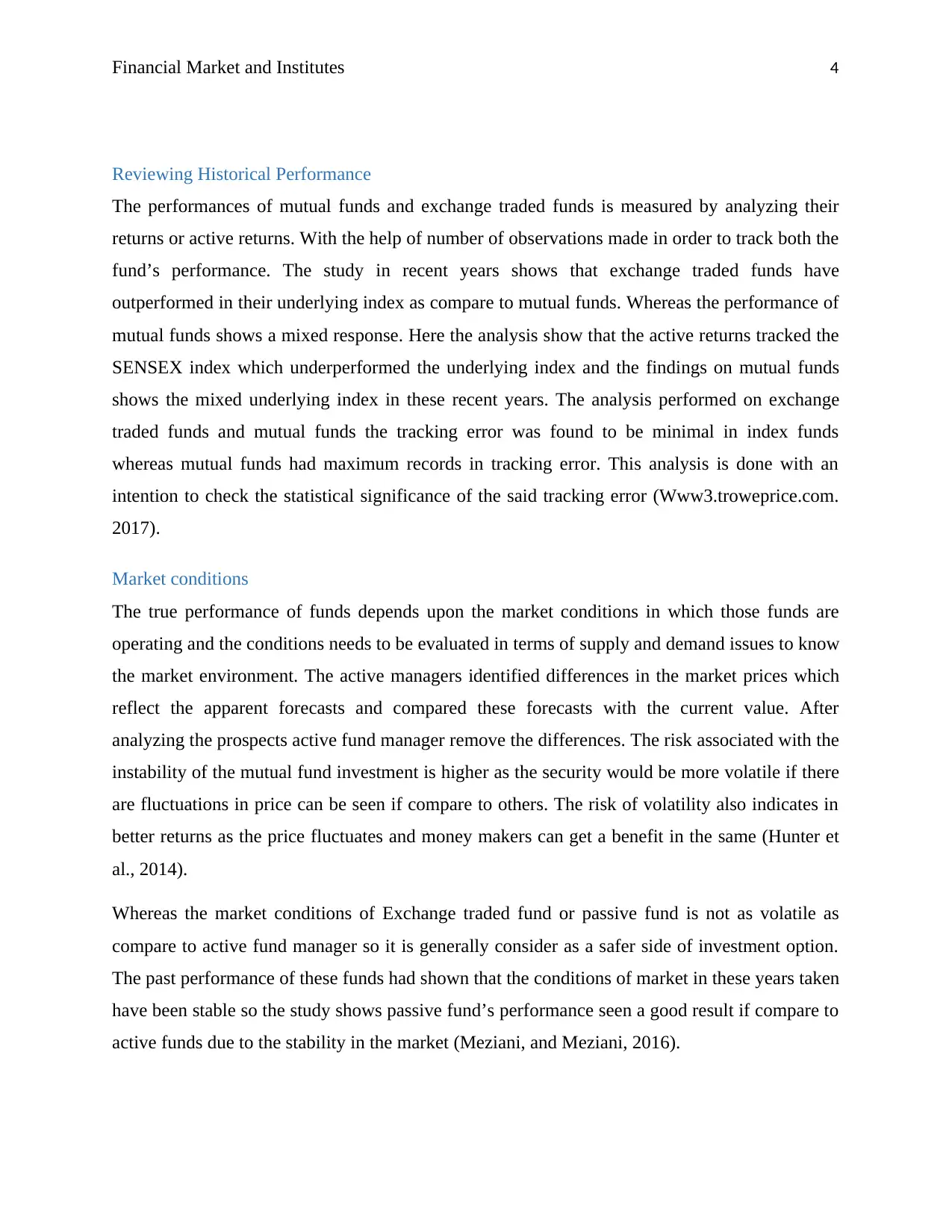
Financial Market and Institutes 4
Reviewing Historical Performance
The performances of mutual funds and exchange traded funds is measured by analyzing their
returns or active returns. With the help of number of observations made in order to track both the
fund’s performance. The study in recent years shows that exchange traded funds have
outperformed in their underlying index as compare to mutual funds. Whereas the performance of
mutual funds shows a mixed response. Here the analysis show that the active returns tracked the
SENSEX index which underperformed the underlying index and the findings on mutual funds
shows the mixed underlying index in these recent years. The analysis performed on exchange
traded funds and mutual funds the tracking error was found to be minimal in index funds
whereas mutual funds had maximum records in tracking error. This analysis is done with an
intention to check the statistical significance of the said tracking error (Www3.troweprice.com.
2017).
Market conditions
The true performance of funds depends upon the market conditions in which those funds are
operating and the conditions needs to be evaluated in terms of supply and demand issues to know
the market environment. The active managers identified differences in the market prices which
reflect the apparent forecasts and compared these forecasts with the current value. After
analyzing the prospects active fund manager remove the differences. The risk associated with the
instability of the mutual fund investment is higher as the security would be more volatile if there
are fluctuations in price can be seen if compare to others. The risk of volatility also indicates in
better returns as the price fluctuates and money makers can get a benefit in the same (Hunter et
al., 2014).
Whereas the market conditions of Exchange traded fund or passive fund is not as volatile as
compare to active fund manager so it is generally consider as a safer side of investment option.
The past performance of these funds had shown that the conditions of market in these years taken
have been stable so the study shows passive fund’s performance seen a good result if compare to
active funds due to the stability in the market (Meziani, and Meziani, 2016).
Reviewing Historical Performance
The performances of mutual funds and exchange traded funds is measured by analyzing their
returns or active returns. With the help of number of observations made in order to track both the
fund’s performance. The study in recent years shows that exchange traded funds have
outperformed in their underlying index as compare to mutual funds. Whereas the performance of
mutual funds shows a mixed response. Here the analysis show that the active returns tracked the
SENSEX index which underperformed the underlying index and the findings on mutual funds
shows the mixed underlying index in these recent years. The analysis performed on exchange
traded funds and mutual funds the tracking error was found to be minimal in index funds
whereas mutual funds had maximum records in tracking error. This analysis is done with an
intention to check the statistical significance of the said tracking error (Www3.troweprice.com.
2017).
Market conditions
The true performance of funds depends upon the market conditions in which those funds are
operating and the conditions needs to be evaluated in terms of supply and demand issues to know
the market environment. The active managers identified differences in the market prices which
reflect the apparent forecasts and compared these forecasts with the current value. After
analyzing the prospects active fund manager remove the differences. The risk associated with the
instability of the mutual fund investment is higher as the security would be more volatile if there
are fluctuations in price can be seen if compare to others. The risk of volatility also indicates in
better returns as the price fluctuates and money makers can get a benefit in the same (Hunter et
al., 2014).
Whereas the market conditions of Exchange traded fund or passive fund is not as volatile as
compare to active fund manager so it is generally consider as a safer side of investment option.
The past performance of these funds had shown that the conditions of market in these years taken
have been stable so the study shows passive fund’s performance seen a good result if compare to
active funds due to the stability in the market (Meziani, and Meziani, 2016).
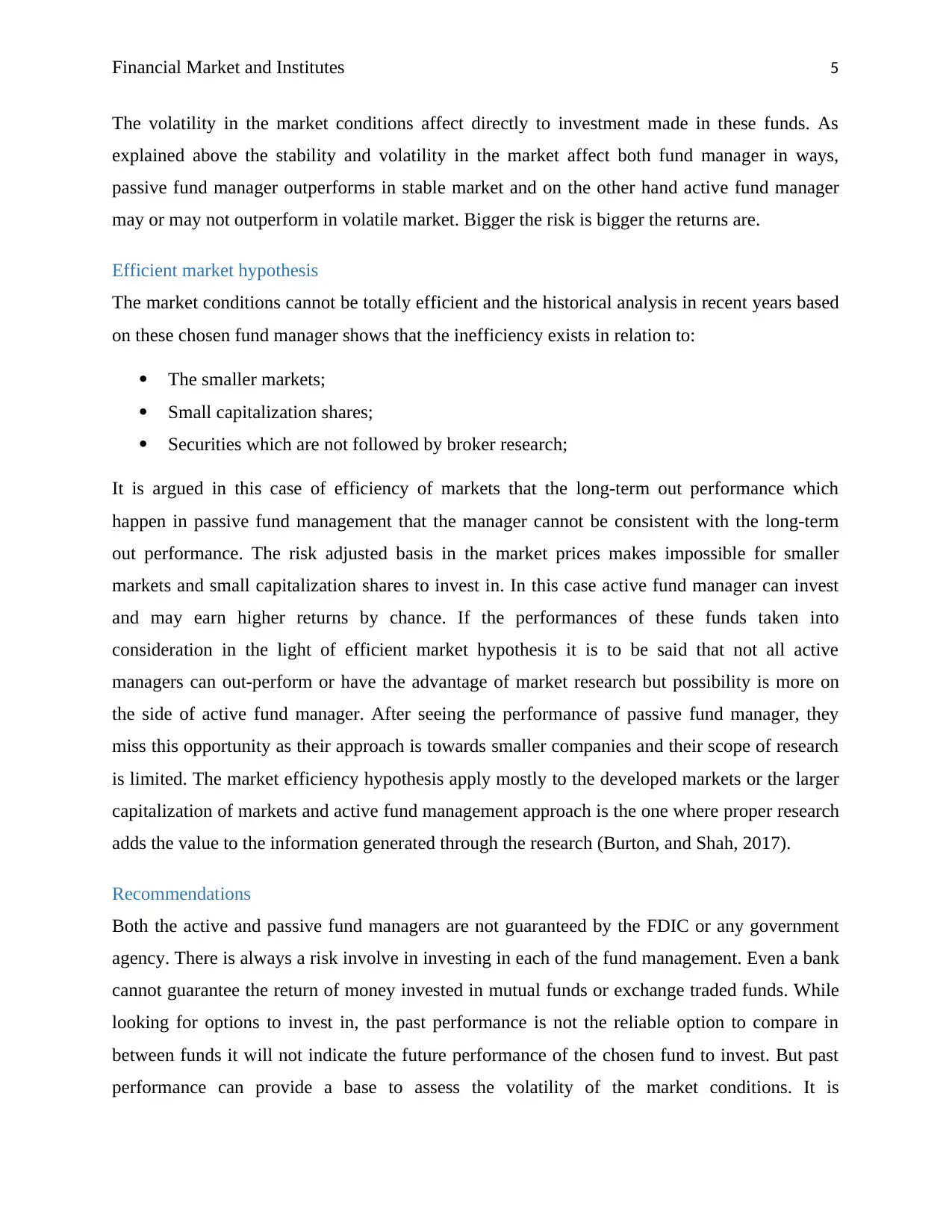
Financial Market and Institutes 5
The volatility in the market conditions affect directly to investment made in these funds. As
explained above the stability and volatility in the market affect both fund manager in ways,
passive fund manager outperforms in stable market and on the other hand active fund manager
may or may not outperform in volatile market. Bigger the risk is bigger the returns are.
Efficient market hypothesis
The market conditions cannot be totally efficient and the historical analysis in recent years based
on these chosen fund manager shows that the inefficiency exists in relation to:
The smaller markets;
Small capitalization shares;
Securities which are not followed by broker research;
It is argued in this case of efficiency of markets that the long-term out performance which
happen in passive fund management that the manager cannot be consistent with the long-term
out performance. The risk adjusted basis in the market prices makes impossible for smaller
markets and small capitalization shares to invest in. In this case active fund manager can invest
and may earn higher returns by chance. If the performances of these funds taken into
consideration in the light of efficient market hypothesis it is to be said that not all active
managers can out-perform or have the advantage of market research but possibility is more on
the side of active fund manager. After seeing the performance of passive fund manager, they
miss this opportunity as their approach is towards smaller companies and their scope of research
is limited. The market efficiency hypothesis apply mostly to the developed markets or the larger
capitalization of markets and active fund management approach is the one where proper research
adds the value to the information generated through the research (Burton, and Shah, 2017).
Recommendations
Both the active and passive fund managers are not guaranteed by the FDIC or any government
agency. There is always a risk involve in investing in each of the fund management. Even a bank
cannot guarantee the return of money invested in mutual funds or exchange traded funds. While
looking for options to invest in, the past performance is not the reliable option to compare in
between funds it will not indicate the future performance of the chosen fund to invest. But past
performance can provide a base to assess the volatility of the market conditions. It is
The volatility in the market conditions affect directly to investment made in these funds. As
explained above the stability and volatility in the market affect both fund manager in ways,
passive fund manager outperforms in stable market and on the other hand active fund manager
may or may not outperform in volatile market. Bigger the risk is bigger the returns are.
Efficient market hypothesis
The market conditions cannot be totally efficient and the historical analysis in recent years based
on these chosen fund manager shows that the inefficiency exists in relation to:
The smaller markets;
Small capitalization shares;
Securities which are not followed by broker research;
It is argued in this case of efficiency of markets that the long-term out performance which
happen in passive fund management that the manager cannot be consistent with the long-term
out performance. The risk adjusted basis in the market prices makes impossible for smaller
markets and small capitalization shares to invest in. In this case active fund manager can invest
and may earn higher returns by chance. If the performances of these funds taken into
consideration in the light of efficient market hypothesis it is to be said that not all active
managers can out-perform or have the advantage of market research but possibility is more on
the side of active fund manager. After seeing the performance of passive fund manager, they
miss this opportunity as their approach is towards smaller companies and their scope of research
is limited. The market efficiency hypothesis apply mostly to the developed markets or the larger
capitalization of markets and active fund management approach is the one where proper research
adds the value to the information generated through the research (Burton, and Shah, 2017).
Recommendations
Both the active and passive fund managers are not guaranteed by the FDIC or any government
agency. There is always a risk involve in investing in each of the fund management. Even a bank
cannot guarantee the return of money invested in mutual funds or exchange traded funds. While
looking for options to invest in, the past performance is not the reliable option to compare in
between funds it will not indicate the future performance of the chosen fund to invest. But past
performance can provide a base to assess the volatility of the market conditions. It is
⊘ This is a preview!⊘
Do you want full access?
Subscribe today to unlock all pages.

Trusted by 1+ million students worldwide
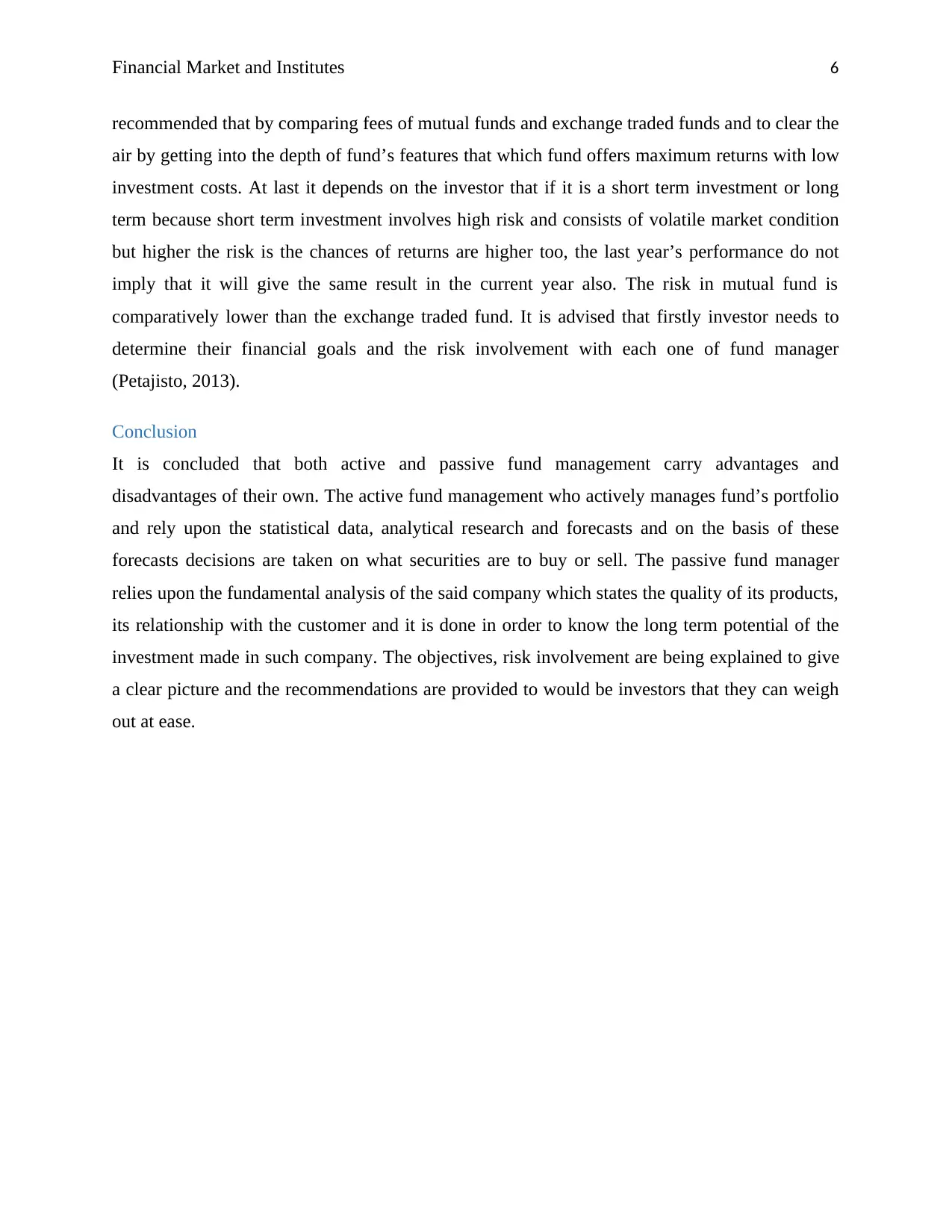
Financial Market and Institutes 6
recommended that by comparing fees of mutual funds and exchange traded funds and to clear the
air by getting into the depth of fund’s features that which fund offers maximum returns with low
investment costs. At last it depends on the investor that if it is a short term investment or long
term because short term investment involves high risk and consists of volatile market condition
but higher the risk is the chances of returns are higher too, the last year’s performance do not
imply that it will give the same result in the current year also. The risk in mutual fund is
comparatively lower than the exchange traded fund. It is advised that firstly investor needs to
determine their financial goals and the risk involvement with each one of fund manager
(Petajisto, 2013).
Conclusion
It is concluded that both active and passive fund management carry advantages and
disadvantages of their own. The active fund management who actively manages fund’s portfolio
and rely upon the statistical data, analytical research and forecasts and on the basis of these
forecasts decisions are taken on what securities are to buy or sell. The passive fund manager
relies upon the fundamental analysis of the said company which states the quality of its products,
its relationship with the customer and it is done in order to know the long term potential of the
investment made in such company. The objectives, risk involvement are being explained to give
a clear picture and the recommendations are provided to would be investors that they can weigh
out at ease.
recommended that by comparing fees of mutual funds and exchange traded funds and to clear the
air by getting into the depth of fund’s features that which fund offers maximum returns with low
investment costs. At last it depends on the investor that if it is a short term investment or long
term because short term investment involves high risk and consists of volatile market condition
but higher the risk is the chances of returns are higher too, the last year’s performance do not
imply that it will give the same result in the current year also. The risk in mutual fund is
comparatively lower than the exchange traded fund. It is advised that firstly investor needs to
determine their financial goals and the risk involvement with each one of fund manager
(Petajisto, 2013).
Conclusion
It is concluded that both active and passive fund management carry advantages and
disadvantages of their own. The active fund management who actively manages fund’s portfolio
and rely upon the statistical data, analytical research and forecasts and on the basis of these
forecasts decisions are taken on what securities are to buy or sell. The passive fund manager
relies upon the fundamental analysis of the said company which states the quality of its products,
its relationship with the customer and it is done in order to know the long term potential of the
investment made in such company. The objectives, risk involvement are being explained to give
a clear picture and the recommendations are provided to would be investors that they can weigh
out at ease.
Paraphrase This Document
Need a fresh take? Get an instant paraphrase of this document with our AI Paraphraser
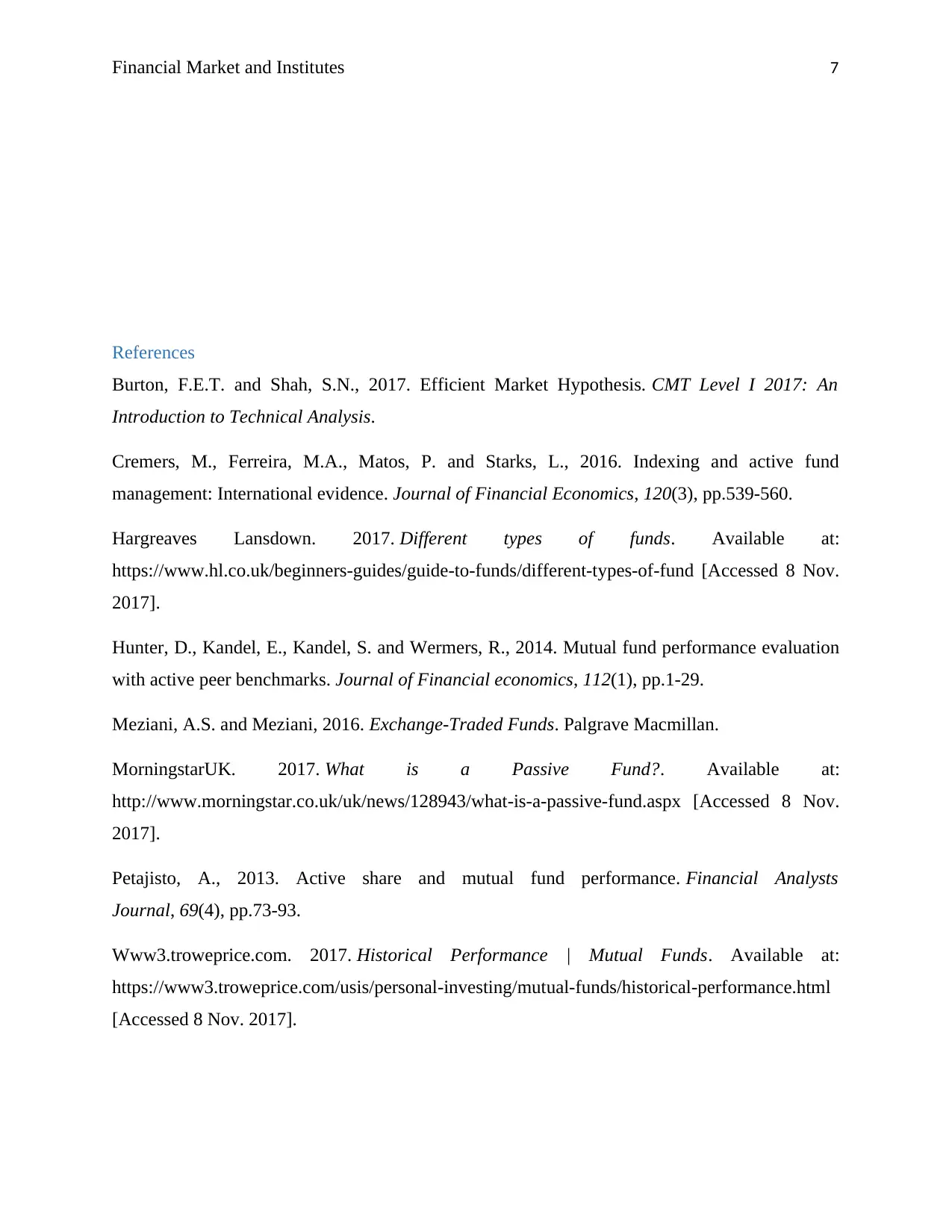
Financial Market and Institutes 7
References
Burton, F.E.T. and Shah, S.N., 2017. Efficient Market Hypothesis. CMT Level I 2017: An
Introduction to Technical Analysis.
Cremers, M., Ferreira, M.A., Matos, P. and Starks, L., 2016. Indexing and active fund
management: International evidence. Journal of Financial Economics, 120(3), pp.539-560.
Hargreaves Lansdown. 2017. Different types of funds. Available at:
https://www.hl.co.uk/beginners-guides/guide-to-funds/different-types-of-fund [Accessed 8 Nov.
2017].
Hunter, D., Kandel, E., Kandel, S. and Wermers, R., 2014. Mutual fund performance evaluation
with active peer benchmarks. Journal of Financial economics, 112(1), pp.1-29.
Meziani, A.S. and Meziani, 2016. Exchange-Traded Funds. Palgrave Macmillan.
MorningstarUK. 2017. What is a Passive Fund?. Available at:
http://www.morningstar.co.uk/uk/news/128943/what-is-a-passive-fund.aspx [Accessed 8 Nov.
2017].
Petajisto, A., 2013. Active share and mutual fund performance. Financial Analysts
Journal, 69(4), pp.73-93.
Www3.troweprice.com. 2017. Historical Performance | Mutual Funds. Available at:
https://www3.troweprice.com/usis/personal-investing/mutual-funds/historical-performance.html
[Accessed 8 Nov. 2017].
References
Burton, F.E.T. and Shah, S.N., 2017. Efficient Market Hypothesis. CMT Level I 2017: An
Introduction to Technical Analysis.
Cremers, M., Ferreira, M.A., Matos, P. and Starks, L., 2016. Indexing and active fund
management: International evidence. Journal of Financial Economics, 120(3), pp.539-560.
Hargreaves Lansdown. 2017. Different types of funds. Available at:
https://www.hl.co.uk/beginners-guides/guide-to-funds/different-types-of-fund [Accessed 8 Nov.
2017].
Hunter, D., Kandel, E., Kandel, S. and Wermers, R., 2014. Mutual fund performance evaluation
with active peer benchmarks. Journal of Financial economics, 112(1), pp.1-29.
Meziani, A.S. and Meziani, 2016. Exchange-Traded Funds. Palgrave Macmillan.
MorningstarUK. 2017. What is a Passive Fund?. Available at:
http://www.morningstar.co.uk/uk/news/128943/what-is-a-passive-fund.aspx [Accessed 8 Nov.
2017].
Petajisto, A., 2013. Active share and mutual fund performance. Financial Analysts
Journal, 69(4), pp.73-93.
Www3.troweprice.com. 2017. Historical Performance | Mutual Funds. Available at:
https://www3.troweprice.com/usis/personal-investing/mutual-funds/historical-performance.html
[Accessed 8 Nov. 2017].
1 out of 8
Related Documents
Your All-in-One AI-Powered Toolkit for Academic Success.
+13062052269
info@desklib.com
Available 24*7 on WhatsApp / Email
![[object Object]](/_next/static/media/star-bottom.7253800d.svg)
Unlock your academic potential
Copyright © 2020–2025 A2Z Services. All Rights Reserved. Developed and managed by ZUCOL.





